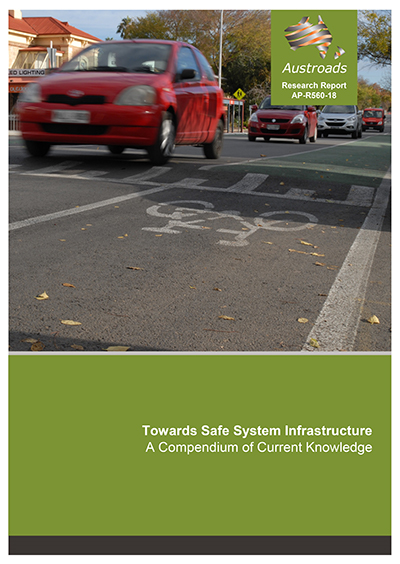Road Safety

- Publication no: AP-R560-18
- ISBN: 978-1-925671-28-5
- Published: 19 March 2018
- PDF (free) Download
This report provides a compendium of knowledge on Safe System treatments and identifies real world experience in the practical application of solutions that can mitigate crash severity.
The Safe System is internationally regarded as the best practice approach to road safety. Although Australia and New Zealand have been early adopters of the approach since 2004, there has generally been a lack of clarity amongst practitioners on how best to integrate the approach into their daily activities.
Assessment frameworks and tools are also now emerging that allow the alignment with Safe System be better quantified. A hierarchy of treatments is described that provide practitioners with a basic understanding of the types of practices that should now be applied on a trajectory towards a Safe System. Primary treatments are capable of virtually eliminating death and injury and certain supporting treatments can transform the network a step closer to reducing the overall harm being caused.
- Summary
- 1. Introduction
- 1.1. Purpose of this report and intended audience
- 1.2. Adoption of the Safe System
- 1.3. What is a Safe System?
- 1.4. The transition to a Safe System
- 1.5. Legal liability issues
- 1.6. Gaps in knowledge
- 1.6.1. Vehicle technologies
- 1.6.2. Rural roads
- 1.6.3. Pedestrians
- 1.6.4. Cyclists
- 1.6.5. Motorcycles
- 1.6.6. Heavy vehicles
- 1.6.7. New modes of travel
- 1.7. Connection with other Austroads Guides and projects
- 1.7.1. Guide to Road Design and Guide to Road Safety Activities
- 1.7.2. Safe System Assessment Framework
- 1.7.3. Safe System Intersection Design Tool
- 1.7.4. Guide to Road Safety Audit
- 2. An Introduction to the Safe System
- 2.1. The ethical and moral imperative for change
- 2.2. Where does the system currently fail us?
- 2.3. How are things different under a Safe System?
- 2.4. Shared responsibility
- 2.5. The business case for the Safe System
- 3. Assisting Road Users to Be Safe Through Planning and Design
- 3.1. Safety and road function
- 3.2. New thinking about road corridor space and movement
- 3.3. Implications for road safety practitioners
- 4. The Role of Speed in Harm Minimisation
- 4.1. The range of speeds on the road network
- 4.2. Stopping distance
- 4.3. Energy transfer
- 4.4. Complications in perceiving speed risk
- 4.5. The association between impact speed and injury
- 4.5.1. Safe System speeds
- 4.5.2. Further insights on speed and injury severity
- 4.6. The association between lower travelling speeds and safety outcomes
- 4.6.1. Nilsson’s Power Model
- 4.6.2. Kloeden curves
- 4.6.3. The case for addressing low level speeding
- 4.6.4. Evidence from speed limit reductions
- 4.7. Speed reductions supported by engineering treatments
- 4.8. Travel time and productivity
- 5. Harm Minimisation at Intersections
- 5.1. Determinants of injury at intersections
- 5.1.1. Post impact vehicle trajectories
- 5.2. Innovation towards harm minimisation at intersections
- 5.2.1. Roundabouts
- 5.2.2. Innovation in intersection design
- 6. Harm Minimisation with High Speed Lane Departures
- 6.1. Reducing the harm of road departures
- 6.1.1. Treatment hierarchy for road departures
- 6.1.2. Clear zones
- 6.1.3. Barriers
- 6.1.4. Unprotected or protected corridors?
- 6.2. Reducing the harm from head-on crashes
- 6.2.1. Treatment hierarchy for head-on crashes
- 6.2.2. Centreline barriers on undivided roads
- 6.2.3. Flexible barriers on divided roads
- 6.2.4. Wide centreline treatment
- 6.3. Safe rural road stereotypes
- 7. Harm Minimisation Amongst Specific Road User Groups
- 7.1. Pedestrians
- 7.1.1. Treatments for pedestrians
- 7.2. Cyclists
- 7.2.1. Treatments for cyclists
- 7.3. Motorcyclists
- 7.4. Heavy vehicles
- 7.4.1. Heavy vehicle treatments
- 7.5. Older road users
- 8. Other Considerations
- 8.1. Intelligent transport systems
- 8.2. Connected and autonomous vehicles
- 9. Tools and Prioritisation Approaches
- 9.1. Approaches to prioritising network treatments
- 9.1.1. Reactive approaches
- 9.1.2. The Australian Road Assessment Program (AusRAP)
- 9.1.3. The New Zealand Road Assessment Program (KiwiRAP)
- 9.1.4. Australian National Risk Assessment Model (ANRAM)
- 9.1.5. New Zealand High Risk Intersection and High Risk Rural Roads Guides
- 9.1.1. Wide Centreline treatment on the Bruce Highway
- 9.1.2. Road Safety Management (ROSMA) framework
- 9.1.3. Commencing the transition towards the Safe System in Victoria - SSRIP
- 9.1.4. The difference between life and death
- 9.2. Current Safe System tools
- 9.2.1. Safe System evaluation framework
- 9.2.2. Safe System Intersection Design Tool
- 9.1. Examples of commencing the transition towards the Safe System
- References
- Resources
- Appendix A Learnings from the Netherlands
- A.1 A European inspired design guide in Australia
- A.2 Midblock
- A.3 Intersections
- A.4 Major intersections
- A.5 Roundabouts
- A.6 Minor intersections
- Appendix B Intersection Design Using X-KEMM-X
